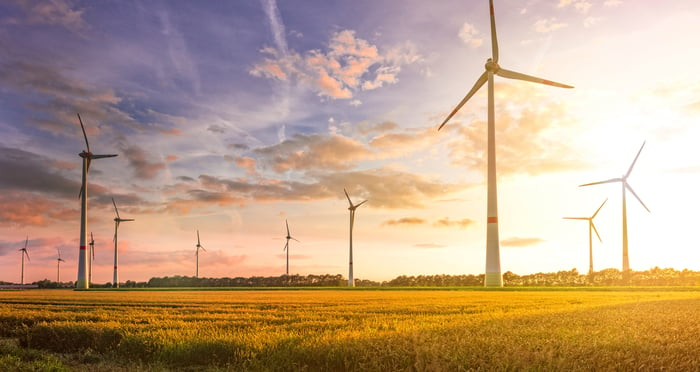Last year, Xcel Energy (XEL 0.93%) became the first utility to commit to reducing its net carbon emissions to zero by 2050. The company's bold goal now is spurring others in the sector to make similar pledges.
While the investments these companies plan to make will undoubtedly be good for the environment, they'll also be good for investors. That's evident in the success of renewable-energy-focused utility NextEra Energy (NEE 1.18%), as well as the earnings-growth projections of the companies making these pledges to reduce their emissions.

Image source: Getty Images.
Putting a greater priority on cutting emissions
Two years ago, Duke Energy (DUK 0.21%) unveiled ambitious goals to reduce its impact on the environment: The utility aimed to cut its carbon emissions 40% by 2030 from 2005's level. It has already slashed them 31% by retiring coal plants and pouring money into renewables. However, with the cost of natural gas, renewables, and energy storage coming down, Duke announced even bolder goals last week. It intends to cut its emissions 50% by 2030, while setting an even more ambitious aim to reach carbon neutrality by 2050.
What makes that such an audacious goal is that it's not possible with existing technology. That's why Duke wants to start investing now, so it can help spur the development of the technologies needed to reach this bold aim.
Joining Duke in targeting zero emissions by 2050 is NRG Energy (NRG 1.83%). The utility is also accelerating its emissions reduction target. In 2014, NRG set goals to reduce its emissions 50% by 2030 and 90% by 2050. However, it's now aiming to reduce them 50% by 2025 and to be net-zero by 2050. Like Duke, NRG realizes that it can't reach that bold goal with existing technologies. That's why it plans to start investing in "forward-leaning technologies" that will help decarbonize electricity production.

Image source: Getty Images.
Investments that should pay dividends for shareholders
Aside from being good for the environment, increased investments in renewable energy have proven to be a money-making strategy for utilities. NextEra Energy, for example, is currently the largest producer of power from the wind and sun, thanks to pouring billions of dollars into renewables over the years. These investments have enabled NextEra to generate above-average earnings growth and shareholder returns. Since 2005, for example, the company has grown its adjusted earnings per share at an 8.5% annual rate, which is the highest among the top ten power companies in the country. That's enabled NextEra outperform the entire utility sector, as well as 86% of the stocks in the S&P 500, over that time frame.
NextEra plans to pour another $25 billion to $28 billion into renewables by 2023. Those investments should help the company grow its earnings per share at 6% to 8% annually through at least 2022. That should enable it to not only continue growing its dividend, but also keep outperforming.
Xcel Energy and Duke Energy also expect that their increasing investments in renewables to reduce emissions will reap big rewards. Xcel's base plan, for example, will see it invest $20.1 billion through 2021, 18% of which will be on renewables. That should enable the company to grow its earnings per share at 5% to 7% annually over that time frame, which should allow it to continue growing its dividend.
Duke, meanwhile, expects to invest another $2.5 billion on renewables over the next few years. Add that to its other investments on cleaner natural gas and on modernizing its electric grid, and the company sees its earnings growing at a 4% to 6% annual pace through 2023. That should give it more money to increase its dividend to shareholders.
Investing for a brighter future
With climate-change concerns growing, more utilities are pledging to be part of the solution rather than contributing to the problem. In the near term, they plan to ramp up their investments in renewable energy; thanks to falling costs, that's becoming increasingly lucrative. They should be able to make a lot of green for their shareholders as they continue going green.
Meanwhile, they also plan to increase their investments in newer technologies to accelerate their commercial viability. Those investments likely won't pay dividends in the near term. But the hope is that they'll pay off in the future, by helping these companies achieve their bold carbon-reduction goals.





